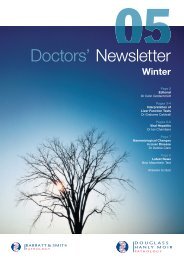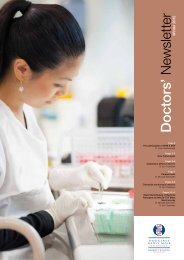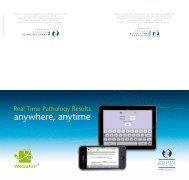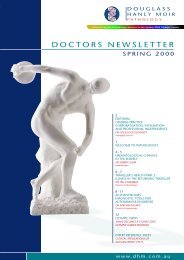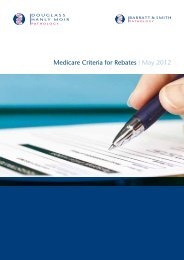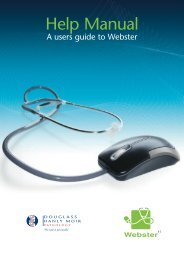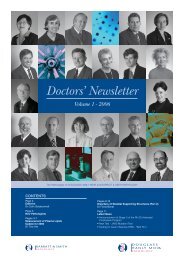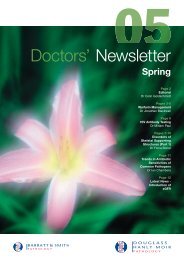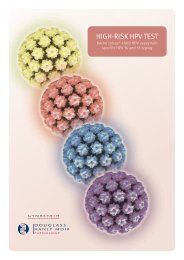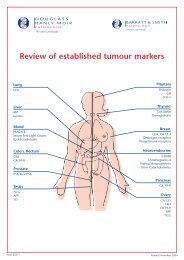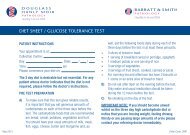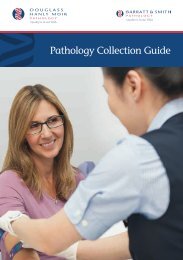Doctors Newsletter - Douglass Hanly Moir Pathology
Doctors Newsletter - Douglass Hanly Moir Pathology
Doctors Newsletter - Douglass Hanly Moir Pathology
You also want an ePaper? Increase the reach of your titles
YUMPU automatically turns print PDFs into web optimized ePapers that Google loves.
SUMMER 2000<br />
Page 2<br />
Editorial –<br />
Partnership<br />
and Core Values<br />
Dr Colin Goldschmidt<br />
Page 3<br />
New Medical Director<br />
Dr Annabelle Farnsworth<br />
New Serology Tests<br />
for Infectious Diseases<br />
Page 4-6<br />
No Spleen – So What?<br />
Dr Debbie Clark<br />
Page 7-9<br />
Infections in Pregnancy<br />
Dr Ian Chambers<br />
Dr Miriam Paul<br />
Page 10-11<br />
TTG – A New Test<br />
for Coeliac Disease<br />
Dr Karl Baumgart<br />
Page 12<br />
Olympic wrap-up<br />
Our Closing Ceremony<br />
<strong>Doctors</strong> ’ <strong>Newsletter</strong><br />
www.dhm.com.au
Editorial<br />
Dr Colin Goldschmidt<br />
Managing Director<br />
Partnership<br />
and<br />
Core Values<br />
Service in Partnership<br />
At <strong>Douglass</strong> <strong>Hanly</strong> <strong>Moir</strong> <strong>Pathology</strong>, we pride ourselves on<br />
the quality of our testing and on the service we provide to<br />
you and to your patients. In addition, as pathologists,<br />
we see our interaction with you fundamentally as a<br />
professional partnership.<br />
Our principal pursuit is to maintain the very highest standard<br />
of scientific accuracy and, to this end, our pathologists,<br />
managers and scientific staff are fully involved in overseeing<br />
all specimen testing and reporting on your patients.<br />
However, we recognise that there are many other facets of<br />
our operation that are important in your assessment of our<br />
service. These include the relationships between our liaison<br />
staff and your practice, our electronic download services,<br />
our couriers and our collection centres and their staff.<br />
Also, because we are committed to offering a personalised<br />
service, we spend much time developing programs on our<br />
mainframe computers that allow customised options to be<br />
made available to satisfy the different needs of our doctors.<br />
In essence, everything that we do is centred on the<br />
concept of a partnership between your practice and<br />
ourselves. In this partnership, we wish to help you,<br />
wherever possible, in your day-to-day practice needs.<br />
Practice Core Values<br />
It is inevitable that the values a company follows impact<br />
directly on the type of service it can provide. Therefore, you<br />
may be interested to know what sort of behaviour we<br />
encourage and adhere to within our organisation, and how<br />
these principles have been developed.<br />
We recently polled the majority of our staff members,<br />
asking them to indicate what core values they believed<br />
were important in an organisation such as ours.<br />
Interestingly, there was significant agreement across our<br />
company and this has allowed us to formalise our core<br />
values in five “plain English” key statements.<br />
These core values affirm that we:<br />
• Commit to service excellence<br />
• Treat each other with respect and honesty<br />
• Demonstrate responsibility and accountability<br />
• Strive for continuous improvement<br />
• Maintain confidentiality<br />
Our core value statements are relevant to each and every<br />
one of us at <strong>Douglass</strong> <strong>Hanly</strong> <strong>Moir</strong>, no matter what our role<br />
or the nature of our job. I believe that we can all be proud<br />
to undertake a commitment to uphold these values and,<br />
in so doing, strengthen and consolidate a culture that<br />
benefits our partnership with you.<br />
Recent Merger<br />
We have recently initiated a merger with our sister practice,<br />
Barratt & Smith <strong>Pathology</strong>, in order to eliminate unnecessary<br />
overlap of our operations and to enhance the delivery of<br />
our services, through the sharing of testing between our<br />
central laboratory in North Ryde and the Barratt & Smith<br />
laboratory in Penrith.<br />
I would like to take this opportunity to warmly welcome<br />
all Barratt & Smith doctors to <strong>Douglass</strong> <strong>Hanly</strong> <strong>Moir</strong>.<br />
I thank you for your cooperation and understanding<br />
through the past weeks of the merger and hope that you<br />
find the new arrangements to your satisfaction. I trust<br />
that this will mark the beginning of a professional<br />
partnership between us.<br />
To all our referring doctors, on behalf of our pathologists<br />
and managers, may I wish you and your families a safe and<br />
peaceful festive season. We thank you very much for your<br />
ongoing support and look forward to further enhancing our<br />
partnership with you into the future.<br />
I warmly invite your comments at any time<br />
and encourage you to contact me via<br />
Phone 98 555 333 or Fax 9878 5066 or<br />
Email colgold@msn.com.au<br />
2
New Medical Director<br />
We are pleased to inform you that, earlier this year,<br />
Dr Annabelle Farnsworth accepted the position of Medical<br />
Director of <strong>Douglass</strong> <strong>Hanly</strong> <strong>Moir</strong> <strong>Pathology</strong>. This senior<br />
medical role was previously held by Dr Colin Goldschmidt,<br />
concurrently with his role as Managing Director. Annabelle<br />
will now fulfil the many functions relating to medical<br />
management at <strong>Douglass</strong> <strong>Hanly</strong> <strong>Moir</strong>. Ours is a practice<br />
that has always been managed by doctors for doctors,<br />
and so the role of Medical Director is an extremely<br />
important one.<br />
As Medical Director, Annabelle is responsible, in<br />
association with our other pathologists and with our<br />
department managers, for ensuring that the highest<br />
clinical and ethical standards are maintained in all areas<br />
of our practice.<br />
In this position Annabelle also takes on the role of<br />
medical representative of our company and, as such, she<br />
welcomes enquiries from doctors, medical practice staff,<br />
hospital staff and others regarding any aspect of our<br />
practice.<br />
Dr Annabelle Farnsworth<br />
Medical Director<br />
Director of Cytopathology<br />
Annabelle continues in her role of Director of<br />
Cytopathology, an area where her considerable expertise<br />
is well recognised. She does, of course, invite doctors to<br />
continue to contact her if they wish to discuss any matter<br />
concerning cytopathology.<br />
We encourage you to contact Annabelle if<br />
she can assist you in any way on<br />
98 555 150 or Toll Free 1800 222 365<br />
New Serology Tests for Infectious Diseases<br />
Herpes specific serology<br />
Herpes simplex type specific serology is now available.<br />
This test reliably identifies those patients who have been<br />
infected with HSV-2 and is of use when lesions are<br />
beyond the stage where culture will be successful,<br />
or when the patient is between episodes.<br />
The test is performed on serum in our Immunochemistry<br />
Department.<br />
Treponemal Antibody Enzyme Immunoassay<br />
Recently DHM has begun to use a Treponemal Antibody<br />
Enzyme Immunoassay in screening for syphilis.<br />
This assay has very high sensitivity and specificity for<br />
the diagnosis of syphilis and will be a useful adjunct to<br />
the other tests currently in use.<br />
Enquiries regarding either of these tests<br />
can be directed to Dr Ian Chambers or<br />
to Dr Miriam Paul on 98 555 311<br />
3
No spleen – So what?<br />
A past history of splenectomy, especially if performed many<br />
years previously, is easily overlooked in a consultation by<br />
both patients and doctors alike. A patient may not be aware<br />
of the details of past surgery or may have forgotten which<br />
organ was removed!<br />
Splenectomy is a not uncommon operation, affecting<br />
around 1 in 1000 members of the population. A practitioner<br />
would therefore expect to have several such patients in his<br />
or her practice.<br />
Lack of a spleen carries a significant lifelong risk of<br />
serious and potentially preventable infection.<br />
Some patients with inflammatory bowel disorders, coeliac<br />
disease, or dermatitis herpetiformis develop splenic atrophy<br />
and so are also at risk.<br />
What are the life-long risks of<br />
splenectomy?<br />
Dr Debbie Clark<br />
Haematologist<br />
All asplenic patients carry the life-long risk of a<br />
fulminant, often rapidly fatal, septicaemia associated<br />
with disseminated intravascular coagulation.<br />
This is usually caused by Streptococcus pneumoniae<br />
(pneumococcus). Such cases have been described more<br />
than 20 years post-splenectomy. (1), (2)<br />
The risk of dying, although unquantifiable, is clinically<br />
significant and the risk lifelong. It is highly likely that most<br />
of these deaths are preventable by means of patient<br />
education, prophylactic antibiotics and vaccination. (3)<br />
It is most important that a patient who has had a<br />
splenectomy knows that it is vital to seek medical attention<br />
immediately if he or she develops a flu-like illness.<br />
Long-term risks of splenectomy<br />
are commonly overlooked.<br />
Recent surveys reveal that only a minority of patients<br />
without a spleen are aware of the risk of sudden<br />
fulminant sepsis.<br />
One reason is that it used to be thought that there<br />
were no long-term problems associated with splenectomy,<br />
and many patients were specifically told at the time<br />
of their operation that there would be no serious<br />
consequences.<br />
Nowadays, however, the increased susceptibility to sudden<br />
and severe infection in splenectomised patients is well<br />
recognised. (4)<br />
It is therefore recommended that splenectomised<br />
patients should be actively sought out and given<br />
appropriate advice. (5)<br />
Who is at greatest risk?<br />
• Children<br />
• Patients in the early post-splenectomy period<br />
• Patients whose surgery was performed for malignancy<br />
or haemoglobinopathy (as compared to those who lost<br />
their spleens as a result of trauma)<br />
How can I know if my patient has had a<br />
splenectomy?<br />
Sometimes, as previously mentioned, the patient may not<br />
be aware of, or has forgotten, details of previous surgery.<br />
• Clues from the blood film<br />
An unexpected clue to the absence of the spleen may<br />
come from a routine full blood count. Patients who have<br />
no spleen commonly have a subtle constellation of<br />
changes on the blood film.<br />
Characteristic changes include the presence of Howell<br />
Jolly bodies, often in combination with target cells, burr<br />
cells, a mild thrombocytosis and occasionally a mild<br />
lymphocytosis. When these changes are seen our<br />
haematologists will comment on possible asplenia.<br />
This may act as a reminder that your patient may<br />
require advice and vaccination.<br />
• If there is any doubt as to the status of a patient<br />
then an ultrasound can be performed.<br />
4<br />
This patient did not know what the scar in the left<br />
upper abdomen signified.
No spleen – So what?<br />
Ideally these are given 14 days prior to splenectomy<br />
– they may be given simultaneously but in separate<br />
syringes and at separate sites.<br />
Booster doses of pneumococcal vaccine and<br />
meningococcal vaccine are recommended every 5 years.<br />
• Prophylactic antibiotics<br />
Consider continuous prophylactic antibiotics for all<br />
patients, but especially for children and for all patients<br />
during the first two years post-splenectomy.<br />
Suggested regimens are: (6)<br />
Blood film from showing post-splenectomy changes<br />
Target cell<br />
Howell Jolly body<br />
Which organisms pose a risk?<br />
• Streptococcus pneumoniae (more than half of cases)<br />
• Neisseria meningitidis<br />
• Haemophilus influenzae type b<br />
• Capnocytophaga canimorsus (animal bites)<br />
• Malaria<br />
• Babesiosis<br />
How can post-splenectomy sepsis be<br />
prevented?<br />
• Increased awareness by clinicians<br />
The risks of splenectomy may not have been<br />
generally appreciated throughout the medical<br />
profession. However, this condition poses an important<br />
public health issue, in that healthy, and often young,<br />
individuals may suffer a serious and potentially<br />
preventable illness. The implication for litigation must<br />
also be recognised, should a doctor fail to inform a<br />
patient of possible risks.<br />
• Patient education<br />
At <strong>Douglass</strong> <strong>Hanly</strong> <strong>Moir</strong> <strong>Pathology</strong> we have<br />
recognised the need for patient education and so, to<br />
assist referring doctors and their patients, we have<br />
published a pamphlet for patients dealing with the<br />
implications of splenectomy. Titled “Have you had<br />
your spleen removed? Facts you need to know”,<br />
this pamphlet is available for you to use in your<br />
practice. The information in the pamphlet is also<br />
available on our website.<br />
• Recommended immunisations for splenectomy (6)<br />
The available vaccines to protect against infections<br />
post splenectomy are:<br />
• 23 valent pneumococcal vaccine<br />
• quadrivalent meningococcal vaccine<br />
• Haemophilus influenzae type b (Hib) vaccine for those<br />
with close contact with children under 5 years of age<br />
• Children under 2 years:<br />
amoxycillin 20mg/kg orally daily<br />
or<br />
phenoxymethylpenicillin 125mg orally 12-hourly<br />
• Adults and older children:<br />
amoxycillin 250mg orally daily<br />
or<br />
phenoxymethylpenicillin 250mg orally 12-hourly<br />
• Patients hypersensitive to penicillin:<br />
roxithromycin 150mg<br />
or<br />
erythromycin 250mg orally daily<br />
• Patient initiated treatment<br />
In view of the fulminant nature of some of the infections<br />
in question, it may be advantageous for the patient<br />
to have a supply of antibiotics to take in case of the<br />
onset of a flu-like illness. Suggested regimens are:<br />
Augmentin 2 tablets stat. (or Bactrim if penicillin<br />
sensitive).<br />
• General practitioner initiated treatment<br />
If the patient consults the doctor with a significant<br />
flu-like illness then Ceftriaxone 1G imi/ivi stat. may be<br />
given prior to transfer to hospital.<br />
• Written information<br />
It may be advisable to provide your patient with written<br />
information to the effect that a splenectomy has been<br />
performed and what is the status of immunisations and<br />
prophylactic treatment. It is also advisable for a patient<br />
to wear a Medic-Alert bracelet indicating their asplenic<br />
condition.<br />
• Travel overseas<br />
Malaria is a much more serious disease in a<br />
splenectomised person. A patient without a spleen<br />
should avoid malarious areas if at all possible. If travel<br />
to these areas cannot be avoided then the importance<br />
of rigidly following prophylactic regimens must be<br />
emphasised.<br />
• Miscellaneous<br />
Animal bites may transmit Capnocytophaga<br />
canimorsus, one of the organisms mentioned above.<br />
Patients should be advised to notify their doctor of any<br />
animal bite.<br />
5
No spleen – So what?<br />
Checklist for doctors<br />
Do you have any patients with a past history of<br />
splenectomy?<br />
If so…<br />
✓ Are they aware of the lifelong risk of overwhelming<br />
post-splenectomy infection?<br />
✓ Have they been given clear instructions about the need<br />
to seek immediate medical attention for flu-like<br />
illnesses?<br />
✓ Have they discussed with you the pros and cons of<br />
penicillin prophylaxis or keeping a supply of antibiotics<br />
at home in case of emergency?<br />
✓ Have they had pneumococcal and other recommended<br />
vaccinations?<br />
✓ Are they aware of the special need for caution when<br />
travelling overseas?<br />
Websites<br />
1. For doctors:<br />
www.rph.wa.gov.au/labs/micro/spleen.html<br />
2. For patients:<br />
www.leukaemia.demon.co.uk/spleen.htm<br />
(Note that this is part of the Leukaemia Research Fund<br />
website but the information is good quality and<br />
applicable to all splenectomised patients. Patients<br />
would of course need advising, where applicable, that<br />
their own condition had no connection with leukaemia.)<br />
3. This article and our patient information leaflet are<br />
available on the <strong>Douglass</strong> <strong>Hanly</strong> <strong>Moir</strong> <strong>Pathology</strong><br />
website: www.dhm.com.au<br />
References<br />
(1) Cullingford G.L. et al. Severe late post splenectomy<br />
infection. Br. J. Surg. 1991 78:716-721.<br />
(2) Lambert H.P. Guidelines for the prevention of infection<br />
in the patient with an absent or dysfunctional spleen.<br />
British Medical Journal. 1996 312; 430-434.<br />
(3) Management of risk of overwhelming sepsis in adult<br />
patients post splenectomy Dr Roger Wilson,<br />
Department of Microbiology and Infectious disease,<br />
Royal Perth Hospital, Perth. 1996.<br />
www.rph.wa.gov.au/labs/micro/spleen.html<br />
(4) Whittaker A. N. Infection and the spleen: association<br />
between hyposplenism, pneumococcal sepsis and<br />
disseminated intravascular coagulation. Med. J. Aust.<br />
1969 1:1213-19.<br />
(5) Spelman D.W. Editorial: Postsplenectomy overwhelming<br />
sepsis: reducing the risks. Med. J. Aust. 1996 164: 648.<br />
(6) Therapeutic Guidelines: Antibiotic<br />
11th Edition 2000/2001<br />
➜<br />
Patient pamphlet<br />
“Have you had your spleen removed?<br />
Facts you need to know”<br />
This pamphlet can be obtained from your Area<br />
Manager or our Stores Department (98 555 210).<br />
For further advice on the issues raised in<br />
this article please do not hesitate to contact our<br />
haematologists or microbiologists<br />
on 98 555 311 or Toll Free 1800 222 365<br />
6
Infections in Pregnancy<br />
Although many women may attend an obstetrician for<br />
ante-natal care, general practitioners are often consulted<br />
for medical problems during pregnancy. One such area is<br />
that of infectious diseases. This article deals with some of<br />
the more serious infections which can occur during<br />
pregnancy and which can be difficult to diagnose.<br />
Many infectious agents can cause problems for either the<br />
mother or fetus in pregnancy. Among these are:<br />
Bacteria<br />
• Syphilis<br />
• Gonorrhoea<br />
• Chlamydia trachomatis<br />
• Group B Streptococcus<br />
• Listeria<br />
• Mycoplasmas<br />
• UTI<br />
Viruses<br />
Others<br />
• Rubella<br />
• Parvovirus B19<br />
• Cytomegalovirus (CMV)<br />
• Varicella-Zoster virus (VZV)<br />
• HIV<br />
• Hepatitis B and C (HBV/HBC)<br />
• Toxoplasma gondii<br />
• Malaria<br />
Dr Ian Chambers<br />
Director of Microbiology<br />
What are the potential problems of<br />
maternal infection?<br />
• Transplacental transmission of some agents to the<br />
fetus during pregnancy can cause congenital<br />
malformations.<br />
e.g. CMV, Rubella, VZV, Syphilis<br />
• Stillbirth and premature labour are possible<br />
complications of some infections.<br />
e.g. Listeria, Bacterial Vaginosis.<br />
• Other organisms may be transmitted in the<br />
peri-natal period.<br />
e.g. Gonorrhoea, Hepatitis B and HIV.<br />
Ante-natal screening in Australia currently<br />
involves testing for:<br />
Rubella (IgG)<br />
Syphilis<br />
Hepatitis B (surface antigen to detect carriers)<br />
Group B Streptococcus<br />
Urine microscopy and culture<br />
The above protocol has been adopted because these<br />
infections can cause significant morbidity. There are<br />
sensitive and specific screening tests for them and safe<br />
and effective intervention is available if infection (or<br />
susceptibility to infection) is detected.<br />
The protocol detects:<br />
• Maternal infection which can be treated<br />
e.g. Syphilis, UTI<br />
• Maternal infection which may require intervention<br />
e.g. Rubella<br />
• Maternal susceptability to infection<br />
e.g. Rubella<br />
• Carriage of infectious agents which require prophylactic<br />
treatment at the time of delivery<br />
e.g. HBV, Group B Strep.<br />
In general, screening for other agents is not recommended<br />
unless there is a specific clinical illness being investigated,<br />
or in situations of specific risk (e.g. HIV).<br />
In particular, the use of IgM assays in asymptomatic<br />
women is inappropriate, as misleading, positive results<br />
can occur.<br />
For example:<br />
Dr Miriam Paul<br />
Clinical Microbiologist<br />
Infectious Diseases Physician<br />
• Persistent positive rubella IgM may occur in pregnancy<br />
• Toxoplasma IgM may persist for many months after<br />
infection<br />
• CMV IgM is commonly seen during reactivation, which<br />
is of little risk to a pregnancy<br />
7
Infections in Pregnancy<br />
Cytomegalovirus (CMV)<br />
Primary infection with CMV in pregnancy is the<br />
commonest cause of congenital abnormality in<br />
Australia. Reactivation is rarely a problem.<br />
Around 50% of the Australian population are immune<br />
to cytomegalovirus (IgG positive). Reactivation during<br />
pregnancy occurs in 10-30% of seropositive women<br />
but rarely causes fetal problems, despite virus being<br />
transmitted to the fetus in 10%.<br />
women who have not received ZIG, once blistering<br />
lesions appear.<br />
The highest risk of fetal damage (2%) from maternal<br />
infection occurs at 13-20 weeks gestation. Skin scarring<br />
in a dermatomal distribution (which occurs due to the<br />
occurrence of shingles in utero), with occasional<br />
associated limb hypoplasia is the commonest malformation.<br />
Neurological abnormalities are much less common.<br />
Primary CMV infection in pregnancy is significant.<br />
• This occurs in 1-2% of seronegative pregnant women,<br />
causing a glandular-fever type of illness.<br />
• Transmission across the placenta causes fetal infection<br />
in 20-50% of cases, leading to fetal damage apparent<br />
at birth in 10% of those infected (i.e. an incidence <<br />
1/1000 pregnancies).<br />
• Severe fetal damage may manifest as a purpuric rash,<br />
hepatosplenomegaly and jaundice, and neurological<br />
damage.<br />
• A further 15% of congenitally infected infants appear<br />
normal at birth but develop late sequelae, particularly<br />
deafness.<br />
Diagnosis of maternal infection is made by serology in a<br />
symptomatic woman, with IgG seroconversion occurring in<br />
association with the presence of IgM. Confirmation of<br />
fetal infection is then made by culture and PCR testing of<br />
amniotic fluid, which is most sensitive after 20 weeks<br />
gestation. CMV viral load in amniotic fluid may be predictive<br />
of the degree of fetal impairment. Serial ultrasound testing<br />
is insensitive.<br />
Varicella-zoster virus (VZV)<br />
This is the causative agent of chickenpox and shingles.<br />
Approximately 90% of Australian adults are immune, even<br />
if they do not recall a past illness.<br />
Primary VZV infection in pregnancy may cause:<br />
• severe, possibly fatal, maternal chickenpox<br />
• congenital malformations in the fetus<br />
• severe neonatal chickenpox (if infection occurs<br />
around term)<br />
Chickenpox in pregnant women only comprises 2%<br />
of all adult chickenpox cases but 25% of all chickenpox<br />
deaths occur in this group. Infection may be more severe,<br />
with pneumonitis, encephalitis and myocarditis occurring.<br />
Prevention of maternal chickenpox is achieved by<br />
administration of Zoster Immune Globulin (ZIG) to<br />
seronegative pregnant women within 72 hours of<br />
significant exposure to a case of chickenpox. Of note, this<br />
may not prevent fetal infection. Aciclovir can be given to<br />
Scarring which occurred as a result of in utero infection with VZV<br />
Neonatal chickenpox can be life-threatening when maternal<br />
chickenpox occurs within the 7 days prior to delivery and<br />
up to 7 days after birth. The high infant mortality rate of<br />
30% is due to transplacental transmission of a large amount<br />
of virus, with no protective maternal antibody yet present.<br />
Management of perinatal maternal chickenpox involves<br />
administration of ZIG to the neonate within 72 hours of<br />
delivery. Maternal shingles is not an indication for ZIG as the<br />
baby receives the mother’s protective antibody transplacentally.<br />
Toxoplasma gondii<br />
This is an ubiquitous protozoan parasite. The cat family is<br />
the definitive host but humans and other animals can also<br />
become infected. In humans infection most commonly<br />
occurs due to eating tissue-cysts in undercooked meat<br />
(e.g. rare steak). Transmission can also occur through<br />
contact with soil and working with animals.<br />
Interestingly, a recent study found no significant<br />
association between infection and the presence of<br />
cats (adult or kitten) in the household. Although cysts<br />
are passed in cat faeces they must mature in soil for<br />
several days prior to becoming infective. The prevalence<br />
of infection is high in some countries (e.g. in France and<br />
Central America it is 80-90%), whereas in Australia only<br />
30-40% of the population are seropositive (i.e. immune).<br />
Congenital infection follows PRIMARY maternal<br />
infection and transmission to the fetus depends on the<br />
stage of pregnancy, being lowest in the 1st trimester (25%)<br />
and rising in later pregnancy (2nd trimester 54%, 3rd<br />
trimester 65%). Conversely, the magnitude of fetal damage<br />
is greatest early in gestation. The majority (85%) of infected<br />
fetuses have mild or sub-clinical infection. Symptomatic<br />
infection at birth consists of neurological abnormalities,<br />
chorioretinitis, jaundice and rash.<br />
8
Infections in Pregnancy<br />
There is no significant association<br />
between infection with<br />
toxoplasmosis and<br />
the presence<br />
of cats or<br />
kittens<br />
in the<br />
home.<br />
Diagnosis<br />
Diagnosis of<br />
infection during<br />
pregnancy can be<br />
difficult, as maternal infection<br />
may be asymptomatic. In symptomatic<br />
women, maternal serology is performed to demonstrate<br />
IgG seroconversion in association with the presence of<br />
IgM. It is important to note that IgM can persist for many<br />
months and even years after infection. IgA detection may<br />
be useful in establishing the timing of infection, as it does<br />
not persist as long. Amniocentesis is then performed at 18<br />
weeks gestation to confirm fetal infection. PCR performed<br />
on this fluid is extremely accurate. Fetal blood sampling in<br />
utero is occasionally performed to measure IgG, IgM, and<br />
IgA, and serial ultrasound may reveal neurological<br />
abnormalities in utero.<br />
Rubella<br />
?<br />
At least 95% of women of childbearing age in Australia<br />
are rubella immune, but congenital rubella still occurs,<br />
especially when primary infection occurs in the first<br />
trimester.<br />
Primary infection in the first trimester results in up<br />
to 90% of fetuses developing major congenital<br />
malformations. Approximately four congenitally infected<br />
children are born annually in Australia, and 25% of the<br />
mothers have no history of exposure or clinical illness.<br />
• When rubella exposure occurs during pregnancy the<br />
index case should be confirmed by serology (detectable<br />
IgM) and the pregnant woman should have IgG and<br />
IgM measured.<br />
• Repeat serology 4 weeks after exposure is<br />
recommended, looking for seroconversion or a<br />
significant IgG rise.<br />
When a positive IgM result is found in pregnancy it has<br />
been established that only 42% are due to acute rubella<br />
infection (this is particularly important in asymptomatic<br />
patients). Sucrose gradient fractionation testing can be<br />
performed at a reference laboratory to confirm whether<br />
this IgM is of recent origin, and thus likely to be associated<br />
with fetal infection.<br />
Reinfection with rubella in pregnancy may occur,<br />
particularly in women with low-level immunity following<br />
vaccination, but the infection is not usually viraemic and<br />
therefore fetal problems are much less common<br />
(around 5%) than in primary rubella infection.<br />
Parvovirus<br />
Fifth disease (also known as slapped cheek disease and<br />
erythema infectiosum) has an incubation period of 1-3<br />
weeks and occurs mainly in primary school age children.<br />
Infection in pregnancy does not result in congenital<br />
malformations but can cause stillbirth in 5-10%, due<br />
to fetal hydrops.<br />
Hydrops develops within 8 weeks of maternal infection<br />
(average 5 weeks) and is most likely when infection occurs<br />
in the second trimester. The condition is due to the<br />
development of anaemia in the fetus, which is more likely to<br />
occur in the second trimester when major RBC<br />
production is occurring.<br />
When exposure occurs in pregnancy<br />
• Maternal immunity (IgG) should be checked, as 50-60%<br />
of the population is immune.<br />
• Symptomatic non-immune women should have infection<br />
confirmed (IgM detected with IgG seroconversion).<br />
• If maternal infection is confirmed, weekly fetal<br />
ultra-sound is performed for 6-8 weeks, looking for<br />
hydrops.<br />
• If hydrops occurs in the fetus, cordocentesis is<br />
performed for fetal diagnosis (by Parvovirus PCR or<br />
IgM) and intrauterine transfusion may be undertaken,<br />
with an 85% success rate.<br />
The overall survival rate of hydropic fetuses is 63%; with<br />
34% of these spontaneously resolving, 33% stillborn and<br />
33% requiring intrauterine transfusion.<br />
HIV<br />
Maternal HIV infection is uncommon in Australia, but only<br />
60% of infected women are diagnosed ante-natally in<br />
Australia. Counselling prior to testing is important as<br />
indeterminate results may occur in uninfected people.<br />
Intervention is possible if infection is diagnosed<br />
ante-natally, and reduces transmission of HIV to the baby<br />
by more than 70% (to about a 5% transmission rate).<br />
Treatment consists of combination antiretroviral drugs for<br />
mother and baby, caesarean section and the avoidance of<br />
breast feeding, which can transmit the virus.<br />
9
TTG – A New Test for Coeliac Disease<br />
Dr Karl Baumgart<br />
Director of Immunology<br />
Autoantibody tests are important tools for the<br />
initial investigation of coeliac disease, which is<br />
then best confirmed by small bowel biopsy.<br />
The recent identification of tissue transglutaminase<br />
(TTG) as the main autoantigen provides a strong<br />
biological basis for a new important laboratory test<br />
for coeliac disease. Detection of TTG antibodies is<br />
now our preferred specific laboratory marker for<br />
coeliac disease, although we will continue to offer a<br />
range of laboratory tests for coeliac disease.<br />
Strategies for best use of these tests, their clinical<br />
significance and common pitfalls in interpretation<br />
of results are described below.<br />
What laboratory tests do we have available<br />
and can you tell me a bit more about them?<br />
IgA and IgG Gliadin Antibodies<br />
IgA and IgG antibodies can be detected by ELISA tests.<br />
The results are reported in “units” and the values of these<br />
results exhibit a good dynamic (broad) range of values.<br />
Usually IgA gliadin antibodies are negative after 6-9<br />
months of a gluten-free diet and IgG gliadin antibodies<br />
become negative after 12-18 months of a gluten-free diet.<br />
This assay is very sensitive, but less specific for<br />
identification of patients with coeliac disease. The results<br />
are almost invariably strongly positive in patients with<br />
coeliac disease not on a gluten-free diet, but low-level<br />
positives do not necessarily have clinical significance.<br />
Thus, although human TTG has been identified as “the<br />
autoantigen” in coeliac disease, the slight differences in<br />
the TTG used in these assays may account for the<br />
observation that this assay does not achieve 100%<br />
sensitivity and specificity. The results exhibit a<br />
reasonable dynamic range, and the results are reported<br />
in units over a “cut-off” value. Although not perfect,<br />
this assay has very high sensitivity and specificity.<br />
IgA antibodies to TTG become negative 9-24 months after<br />
commencement of a gluten-free diet.<br />
This assay is now our preferred specific laboratory<br />
marker for coeliac disease testing.<br />
What are the pitfalls in interpreting these<br />
test results?<br />
• IgA-dependent serology is useless in patients with IgA<br />
deficiency, which occurs in 1:300 of the population,<br />
so measuring total IgA is a necessary part of the<br />
laboratory investigation.<br />
• Gluten restriction will result in lowering and<br />
subsequently disappearance of all of the lab markers.<br />
• Do not forget clinical syndromes from wheat<br />
exposure may result from other mechanisms including<br />
IgE-mediated wheat allergy, non-immunological<br />
intolerance of wheat or preservatives used in wheat<br />
products (propionates).<br />
If I have to persuade the patient to eat<br />
wheat again for the sake of some tests,<br />
how long do they have to do this for?<br />
?<br />
These tests mainly have utility for monitoring patient<br />
compliance with a gluten-free diet.<br />
IgA Endomysial Antibody<br />
This antibody is detected by indirect immunofluorescence<br />
on a glass slide of primate oesophagus. Of the assays<br />
available, this assay has the greatest specificity, but on<br />
occasion it can be less sensitive. In most patients with<br />
coeliac disease, this assay becomes negative after 12-18<br />
months of a gluten-free diet.<br />
10<br />
IgA Tissue Transglutaminase Antibody (New test)<br />
This antibody is detected by ELISA assays. There are<br />
subtle differences between the different commercial<br />
assays for this autoantibody since some use recombinant<br />
antigens and others use TTG purified from guinea pig.<br />
A minimum of two weeks of regular wheat intake would be<br />
a reasonable “rechallenge” period.
TTG – A New Test for Coeliac Disease<br />
What tests should I request when I am<br />
considering the diagnostic possibility of<br />
coeliac disease?<br />
Coeliac screens should always include a total IgA,<br />
one sensitive marker and one specific marker.<br />
Our recommendations may alter along with further<br />
changes in tests but at present we would recommend:<br />
PREFERRED OPTION<br />
Total lgA<br />
Gliadin IgA, IgG antibodies<br />
Tissue transglutaminase IgA antibody<br />
Are the lab tests going to be helpful if I<br />
am sending my patient for an endoscopy<br />
anyway?<br />
If the laboratory tests for coeliac disease are negative,<br />
you will not have to refer a patient for an endoscopy to<br />
eliminate coeliac disease, but endoscopy may still be<br />
appropriate if clinical entities other than coeliac disease<br />
are to be considered.<br />
Followup endoscopy may not be needed If patients<br />
have a good clinical response to gluten-restriction and<br />
demonstrate normalisation of laboratory markers of coeliac<br />
disease (gliadin, endomysial or tissue-transglutaminase<br />
antibodies) and its consequences (iron deficiency, changes<br />
in blood count at presentation). However, for most patients,<br />
a progress endoscopy after introduction of gluten restriction<br />
is not unreasonable.<br />
If discordant, then do Endomysial IgA<br />
➜<br />
➜<br />
ALTERNATIVE OPTION<br />
Total lgA<br />
Gliadin IgA, IgG antibodies<br />
Endomysial IgA antibodies<br />
If discordant, then do TTG IgA<br />
Normal duodenal mucosa. Note the long, “finger-like” villi on the surrface.<br />
The alternate specific marker should be requested<br />
if there are discordant results. The same antibody<br />
markers should then be used for monitoring the<br />
effect of gluten restriction.<br />
How do serum markers relate to the need<br />
for endoscopy and biopsy?<br />
Patients with adequate gluten intake (at least two weeks<br />
of regular wheat) should be referred for serology before<br />
biopsy as negative serologic markers may raise the index<br />
of suspicion for other clinical problems!<br />
Patients with unequivocally positive coeliac markers or IgA<br />
deficiency should be referred for endoscopy and biopsy to<br />
document the extent of mucosal abnormality and confirm a<br />
histological diagnosis.<br />
Duodenal mucosa in coeliac disease. Note that the surface is almost flat<br />
(“sub-total villous atrpophy”). These mucosal changes can revert to<br />
normal or near normal on a gluten-free diet.<br />
11
Olympic wrap-up<br />
Our Closing Ceremony<br />
We have now completed our involvement with the Sydney<br />
2000 Olympic and Paralympic Games. Like other support<br />
services associated with the staging of the Sydney 2000<br />
Games, we are pleased to be able to say that all went<br />
according to plan.<br />
Sonic Healthcare was the Official Provider of <strong>Pathology</strong><br />
Services for athletes and Olympic Team members. Sonic<br />
laboratories around Australia were involved in testing of<br />
athletes prior to the Games, however, <strong>Douglass</strong> <strong>Hanly</strong> <strong>Moir</strong><br />
<strong>Pathology</strong> was responsible for setting up the laboratory in<br />
the Polyclinic at the Athletes’ Village and for conducting<br />
testing during the actual Games period. The laboratory was<br />
completely fitted out and was functioning at a NATA approved<br />
standard within a few weeks – something of a record!<br />
Dr Grahame Caldwell was the Medical Director of the<br />
laboratory and Sally Johnston, who is our Laboratory<br />
Manager at Mater Hospital, Crows Nest, also took on the<br />
role of Laboratory Manager at Homebush Bay. Geoff<br />
Gibson, our Administration Manager, was Director of<br />
<strong>Pathology</strong> at the Olympic laboratory and had overall<br />
responsibility for our operation.<br />
During the Games period our laboratory was open<br />
15 hours a day and we also provided an out of hours<br />
service for emergencies.<br />
Although our on-site laboratory staff members were in the<br />
centre of the “action” – the laboratory overlooked the main<br />
stadium – because of the special involvement of our practice<br />
at the Games, our entire staff felt part of the experience.<br />
We were kept up to date with the happenings at Homebush<br />
Bay through staff bulletins; our courier cars all flew the<br />
Australian flag and, like many others around the country, we<br />
followed the events on “the big screen” at every opportunity.<br />
The Polyclinic had its own closing ceremony (a party!).<br />
Then the lab was dismantled – again in record time. We<br />
understand that the area where our laboratory was situated<br />
will become part of a new primary school.<br />
We are proud of the part our practice played during the<br />
Sydney 2000 Olympic and Paralympic Games.<br />
12<br />
DOUGLASS HANLY MOIR PATHOLOGY PTY LIMITED • ABN 80 003 332 858 95 EPPING ROAD • NORTH RYDE • NSW 2113 • AUSTRALIA<br />
A subsidiary of SONIC HEALTHCARE LIMITED<br />
TEL 98 555 222 • FAX 98 555 111<br />
MAIL ADDRESS • LOCKED BAG 145 • NORTH RYDE • NSW 1670 • AUSTRALIA



